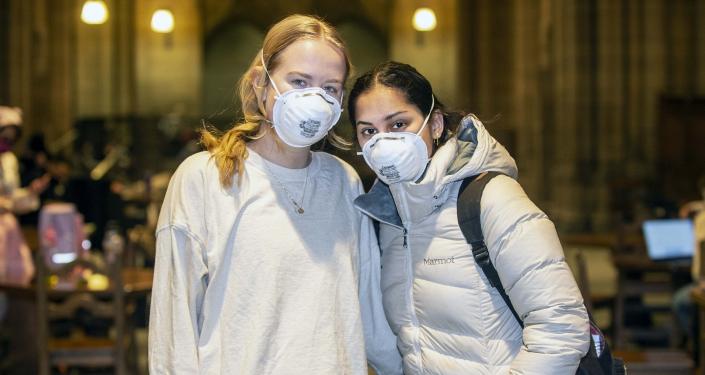By J.D. WRIGHT
This year, as we consider the relationships among data, technology and social issues like equity and inclusion, wehave a good opportunity topause to think aboutthe “digital divide” — “the gap between those who have access to technology and those who do not” (Huffman 2018, p. 239) — and how we as faculty can help disadvantaged students whomight desperatelyneed support.
The effect of the global COVID-19 pandemic also makes the digital divide a timely concern, because the widespread shift to remote and hybrid instructionmodelsexposedsignificantgaps in equitable access to technology (bandwidth, equipment and know-how) — gaps that have not yet been sufficiently addressed (Correia 2020, p. 14).
Lack of technological access at the college level correlates closely with income and race. For example, according to a Pew Research study, only 2 percent of households with incomes over $75,000 per year lackedinternet access, whereas forhouseholdsearning less than $30,000 annually,21 percentlacked basic broadband internet(Huffman 2018, p. 240).Students with even lowerincomes and students from minoritizedcommunities often have evencorrespondinglylower internet-access rates (Huffman 2018, p. 240), whether due to a lack of internet connections,inadequate or unavailable equipmentandsoftware,orinsufficientknowledgeabouthow touse technology.
Even in the face of this data, however, it is all too easy to assume that our students — part of the so-called “digital native” cohort — are entirely self-sufficient and do not need technological assistance. But a better practice is tooperate with anentirely different set of assumptions: (1)studentsmight be less technologically savvy than their instructors; (2) they might behamstrung by limited bandwidth on their phones or other devices; and (3) theymightnot ownequipmentlike printers and scanners (Correia 2020, p. 15).
The effect of thesechallenges, although probably felt and evidenced most acutely in the online-learning model, permeates the academy. Imagine, for example, being an off-campus student without access to broadbandand without an easy way to get to the library. How do you perform online research effectively with a slow or unreliable connection? How do you edit and process your files on outdated technology or software or on a machine that is far less than state-of-the-art? How do you cope with quizzes and exams that are administered online?These conditions are concrete and very real for many of our students, even though the subject is rarely broached (by them or by us), and the onus rests on front-line faculty to help our students adapt.
Existing resources

A first step toward helping to bridge the digital divide and toward supporting students who might be technologically disadvantaged is to become familiar with and then publicizeassets that the University already has available to students in need.Here are a number of useful resources;we recommend that you become acquainted with them and thenpost links to these resources inyoursyllabi and/oryourCanvas sites:
More equitable onlineand technology-enhancedteaching
Awareness of the problem that some students have in online-learningand technology- enhanced learningenvironments is an important first step. A good second step is effective planning and strategizing about how to enhancedigitalequity in your teaching practices.
In this regard, Daniel Stanford(2020)has developed a useful visual tool, available on a Creative Commons license, that can help you to conceptualize the trade-offs that often animate onlineand technology-enhancedteaching. Stanford arrays different technological tools along two dimensions: the immediacy with which the technology enables content to be delivered and the bandwidth that is consumed to deliver that immediacy.The Stanford Bandwidth Immediacy Matrix is the result.
Low-bandwidth technologies can be favored in online-teaching scenarios in order to supportstudents with limited technological access, and this can be done without sacrificing immediacy by adopting the right technological tools, like collaborativedocuments and group messaging platforms. This is not to say that you are limited to the low-bandwidth/high-immediacy quadrant of the matrix, only thatother quadrants raise distinct challenges that you might want to address, with help and support from theTeaching Center, in order to assist your students in the online-learning enterprise.
For example,livevideo conferencing platforms like Zoom convey material with a high degree of immediacy while consuming large amounts of bandwidth — alternatives exist, like using asynchronous recordings, transcripts, discussion boards and audio (Correia 2020, p. 16).
Likewise, there is a large range of alternative assessment options besides online quizzes and exams,whichcan be unstable for students struggling with inadequate technology: open-book exams can be suitably rigorous if planned properly; electronic portfolios teach technological skills and provide students with a high degree of autonomy and pride in their work (Correia 2020, p. 18).
Conclusion
The Year of Data and Society is a perfect opportunity to become aware of the digital divide and tointentionally develop ways to help address it. For a consultation on these issues or other teaching concerns, please contact theTeaching Centerfor help.
J.D. Wright is a teaching consultant with the University Center for Teaching and Learning.He can be reached atjd_wright@pitt.edu.
References
Correia, Ana-Paula. 2020. “Healing the Digital Divide during the COVID-19 Pandemic.”Quarterly Review of DistanceEducation21(1): 13-21.
Huffman, Stephanie. 2018. “The Digital Divide Revisited: What Is Next?”Education138(3): 239-46.
Stanford, Daniel. 2020.“Videoconferencing Alternatives; How Low-Bandwidth Teaching Will Save Us All.”




